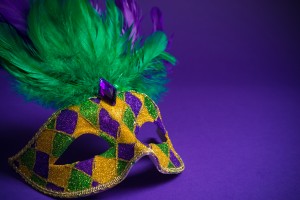Mob Blog: Mardi Gras, January 28, 2016
I looked at my calendar today and realized that Mardi Gras is just around the corner. This doesn’t mean much to most Yankees, but I’ve an ongoing love affair with the city of New Orleans. The Big Easy also happens to be Louie Morelli’s hometown, and is featured extensively in my novels. In fact, the final scene in Louie Morelli’s Mistress takes place on Mardi Gras.
Mardi Gras, also known as Shrove Tuesday, translates to Fat Tuesday in French. It’s a Catholic holiday, a celebration of excess because the day after Mardi Gras is Ash Wednesday, the beginning of lent and a time of fasting.
Mardi Gras is not unique to New Orleans, but no other city in America celebrates this pre Lenten festival with such flair as the Big Easy. The Carnival season begins on Twelfth Night, which is the conclusion of the twelve days of Christmas and the night before the Feast of Epiphany. Society balls commence with the Twelfth Night Revelers ball, held this year at the Ritz-Carlton on January 6. At this time King Cakes appear in bakeries and supermarkets.
Mardi Gras, also known as shrove Tuesday, translates to Fat Tuesday.
The King Cake is a circular ring cake made of Danish dough and decorated with festive frosting in gold, green and purple—the colors of Mardi Gras. Baked into one of the slices is a small plastic baby or, traditionally, a bean. The person who receives the slice with the baby is considered lucky and is generally chosen to host the next “King Cake” party.
Although Carnival celebrations were present in some form or another in early New Orleans, it didn’t become organized until the 1850’s when a group of young men formed The Mystick Krewe of Comus and launched the first parade, with mule-drawn floats carrying masked riders.
In the 1870’s Rex arrived as a mock monarch and soon became known as the King of Carnival, with the Rex parade becoming the major parade on Mardi Gras. As with Comus, the Rex organization is comprised of Uptown bluebloods. But other “krewes” soon formed, and it is these private organizations and secret societies that fund the Carnival magic. The cost to the city is minimal, consisting mainly of added police protection.
No longer the exclusive domain of white male aristocrats, parading krewes represent the cultural diversity of New Orleans.
Nowadays, there are a number of krewes that parade and some that don’t, plus the suburban krewes and celebrations. No longer the exclusive domain of white male aristocrats, parading krewes represent the rich cultural diversity of New Orleans, with many African-American and gay krewes offering some of the best entertainment of the season.
Competing krewes start parading at least two weeks prior to Mardi Gras, with the big events slated for the last weekend before the big day. This is when tourists jam the city and the party really kicks in. To get a firm grasp of the enormity of it all, visitors should check out Blaine Kerns Mardi Gras World, where artisans work year round creating floats for forty parades. Celebrations continue throughout the day on Mardi Gras, ending abruptly at midnight, when Lent begins.
Patricia Bellomo is the author of the “Louie Morelli” series. Books include Louie Morelli’s Mistress, Stella di Mare, Louie Morelli’s Daughter, and the award winning The Prince of Mafia Princes. All books available via Amazon or the author’s website.




